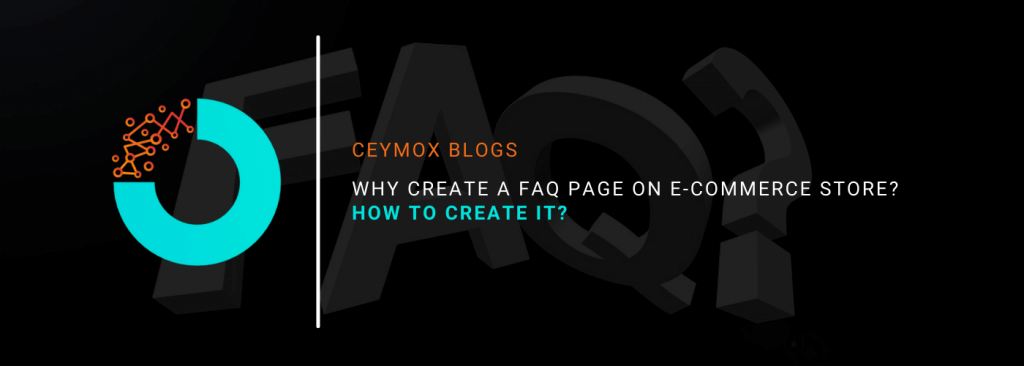
A FAQ page is one of the most underrated features that you may overlook while developing an e-commerce store. A FAQ page is not just limited to answer the common questions of the customers but it can play a major role.
The FAQ section if created properly can be an effective addition to your website and serve multiple purposes such as:
- Reduces the purchasing anxieties of customers that the product page doesn’t directly address
- Exonerate your customer support team from some burden by publicly answering some common questions
- Improves SEO and site navigation
- Earns trust by demonstrating product expertise and explaining your business model
- Delight customers by answering their questions
If you haven’t created a FAQ page in your e-commerce store or haven’t realized its potential yet, this article will help to know this often-forgotten section of most websites. In this article, we have covered almost every aspect of a FAQ page.
FAQ page: Introduction
Unlike the landing page, where the aim is to convert buyers, the FAQ page or FAQ section is a part of your site in which you answer customers’ frequent questions, concerns, and objections they may have.
Don’t confuse it with the About Us Page in which you tell the story of your company, team, or your brand. On the other hand, the FAQ section deals with the details. It is the ultimate point where customers can find answers to specific questions about your product.
A FAQ page may even be the first point of contact for customers looking for answers to their queries before making a purchase. If used right, a FAQ page can benefit customers at different points of their shopping journey. In simple words, a FAQ has the potential to reduce the anxiety of purchasing online – and that goes a long way in getting on-the-fence customers to buy from you.
When is a FAQ page appropriate?
An FAQ page can act as an asset or even distracts your customers, depends on the way you execute it. But to make sure it becomes an asset, here are some scenarios indicating that it is time to create a FAQ page as part of your website:
- You are getting e-mails from your customers with the same questions on a regular basis, then it is better to answer them publicly and properly.
- You want to create content/landing pages that you can link to and continue the journey from question to conversion.
- Your offerings or business raise questions and concerns that are better handle in a straightforward manner.
The last point is highly important as a FAQ page gives you a unique opportunity for directly addressing concerns and removes any roadblocks related to purchasing.
How to find the “Frequently Asked” Questions?
You must first check your inbox and customer support tickets. But you should also anticipate objections that you can turn into questions, especially if the answer will simplify the customer’s mind.
Consider how to create the right questions to educate customers about your offerings. While deciding the questions for your FAQ section, focus on relevancy, utility, and opportunities of turning the question into the conversation. If you have created a huge list of questions, categorize your questions under “shipping” or “about the product” for easy navigation.
If you don’t have e-mails or customer supports ticket, you can wander through your competitors’ FAQs, reviews of your products, and forums like Quora or Reddit to know what are the common questions related to your products.
How to answer the FAQs?
How you answer the questions plays a significant role. Even if the question is about a potential shortcoming in your product or business, put on your PR hat and put a positive spin on your answer. You can show depth in your answers but make sure you don’t lose your customers by giving them more than they need.
Also, always write the questions from the perspective of customers such as “How do I…” and give answers from your business perspective like “You must…” or “We deliver…”
Focus on clear communication first and then try to achieve the goal with each FAQ question. Are you addressing a concern about purchasing from you? Educating your audience about a part of your business model? Troubleshooting a common problem with your product? Focus on delivering that in your answers. If relevant use images and videos in your answers.
A common missed opportunity in FAQ pages is ending an answer with a CTA (Call-to-action) that links to other pages to push visitors back into the funnel. Consider what would be the next step of a visitor after getting an answer for a query, the visitor will try to find the link relevant to that question and continue the buying journey.
How the FAQ section is helpful for SEO?
Many e-commerce stores have a standalone page for the FAQ section that uses the Q & A format to communicate information. Although this serves the main purpose of a FAQ page – to overcome any obstacle on the path to purchase – you can also create a FAQ section with dedicated pages for each question. This will increase the search friendliness of your website.
By providing a hyperlink to a page in each FAQ question, you can let the search engines crawlers crawl the page. It is possible that the audience is not searching about your brand but they may be searching for answers to questions related to your offerings on Google. This increase the discoverability of your e-commerce store as the content is optimized for these specific search queries.
Where to put the FAQ section?
Well, it depends. If the core of your business is customer service, you may need to create a fully fleshed out support centre or “help desk”, using any 3rd party customer service providers such as HelpDesk or Zendesk. It will also incorporate FAQ as part of your customer support flow (i.e. customers go through the FAQ first before they reach out to the customer support executive).
But if you are selling products or services which can arise many queries then it is better to display a link to a simple FAQ page on your website navigation. You can also incorporate FAQs into your product pages as well. It can be your product descriptions part and placed at the bottom of the page, just above or below customer reviews.
FAQ page template:
Just like the template of the About us Page, there is no universal FAQ template that you must follow. But there are some generic questions common in every industry. Here you can find few relevant questions for your store:
- What are the shipping options?
- How to get free delivery?
- When will I receive my order?
- What should I do if I get a defective order?
- Can I cancel/change my order?
- How can I look up my order?
- Do you ship internationally?
- How to return/exchange an item?
- How to avail discounts/coupon codes?
After knowing the basics down, find more related questions to your business. This is where the insights from tickets and e-mails will help you.
Security and Safety:
You will want to assure your customers of their data privacy and security. It is also important to address any common questions related to the safety of using the product. For e.g., if you are offering software or an app on your site, then you can share information of what data you will collect.
Account Management:
You can help the customers with how they can manage their accounts. Many customers have queries related to how they can add multiple addresses, change their payment methods etc.
Product features and brand promises:
What makes your products and brand different from others, and what questions do customers may have about this? You can use FAQs to reiterate your messaging. There are many cosmetic brands that use FAQ pages to talk about cruelty-free products and the queries customers have around that.
Using the product:
The FAQs purpose is not limited to just persuade the customers to make a purchase but also to help customers who have made a purchase. Create questions relevant to how to use the product, how to counter the common issue related to the product and other questions.
Best Examples of FAQ Pages to Consider:
Here are some examples of FAQ pages that you can consider while creating the FAQ page of your e-commerce store:

Mahabis has beautifully overcome the common obstacle with standard FAQ pages. Instead of displaying a huge paragraph with lots of content, they have organized everything systematically in topics. By this approach, the customers can quickly find the information they concern about without necessarily being forced to scroll through the irrelevant text.
Also, you can quickly notice that there are brief but yet detailed answers on the Mahabis FAQ page. There is no beating around the bush here. The answers are direct to the point and address the issues in the fewest words possible. In case, customers want more detail then they can click on the hyperlink to more detailed sections of the website.
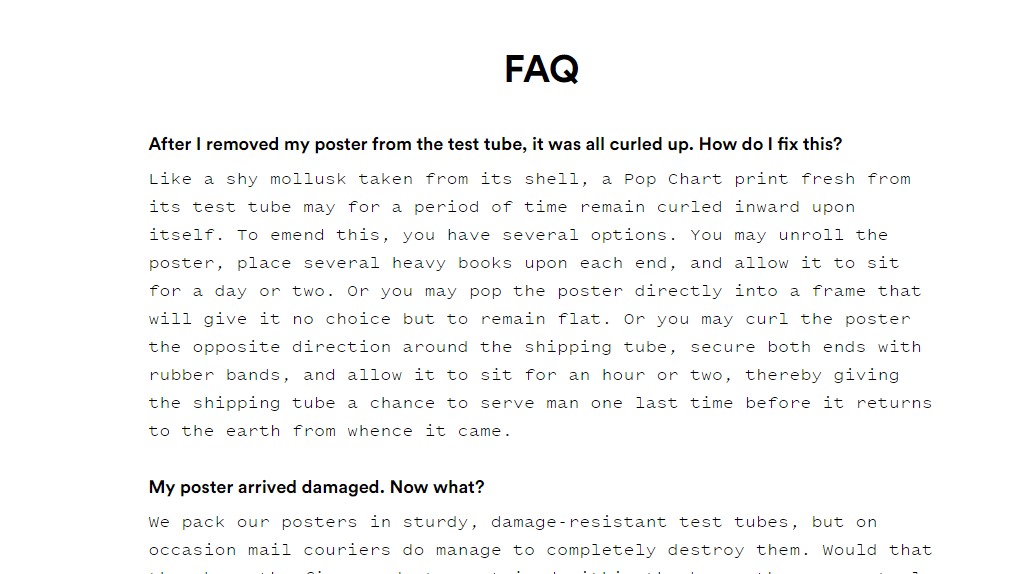
PopChart’s FAQ page is quite opposite to that of Mahabis’. The answers on the page are not short. PopChart is quite a small company which only deals with infographic posters. Thus it is obvious that there will be limited questions that visitors and customers might have. All this has been addressed in the simplest way possible.
Another noticing thing about this page is the answers’ tone and language. Both the questions and answers are not written in the formal language. Rather, the support team has used a pure conversation approach.

While the common thing in FAQ pages is questions and answers, Greats have used a more intuitive approach to address customer queries. They have used tables, images, and buttons on the text to help customers easily understand. It is obvious that here the customers can remember the stuff easily in comparison to other typical FAQ pages.
For an even better experience, there are no questions on the Greats’ FAQ pages. Instead, it throws a brief statement in bold at you then proceeds to outline the answers. It is like a mini information page than a website with proper FAQs.
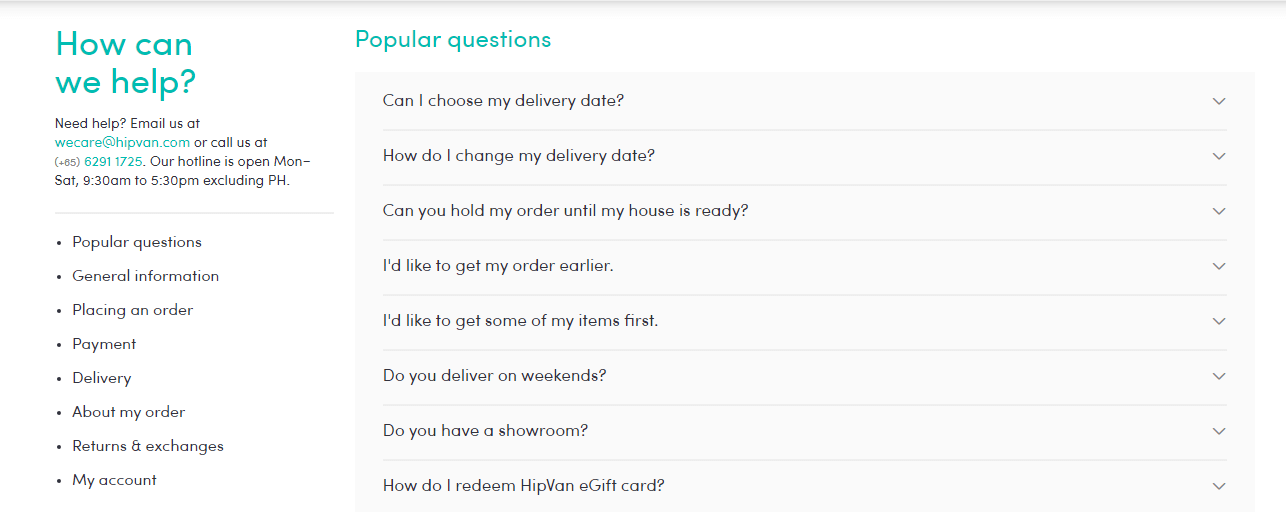
If you are looking for a well-structured FAQ page, then the HipVan FAQ page is the best consideration. It has an extensive series of questions, with popular enquiries, general information, and issues related to the entire shopping process including order replacement and refunds. For properly organizing all this, the FAQ page has been divided into 8 straightforward topics.
There is an expand button next to every question for revealing the corresponding answers. This feature hides the irrelevant that a customer may not be interested in, consequently keeping the page short and orderly.

Who says that an FAQ page has no role in conversion rates? Bando is a perfect epitome of how you can leverage even customers’ queries to drive sales. The questions on the FAQ page are what a potential lead would ask before making a purchase such as “Is your website secure?” and “what is your wholesale policy?”
Bando then cleverly promotes itself with properly written SEO optimized answers. There are promo codes, discount guarantees, and various customer assurances that will compel you to proceed with the checkout.
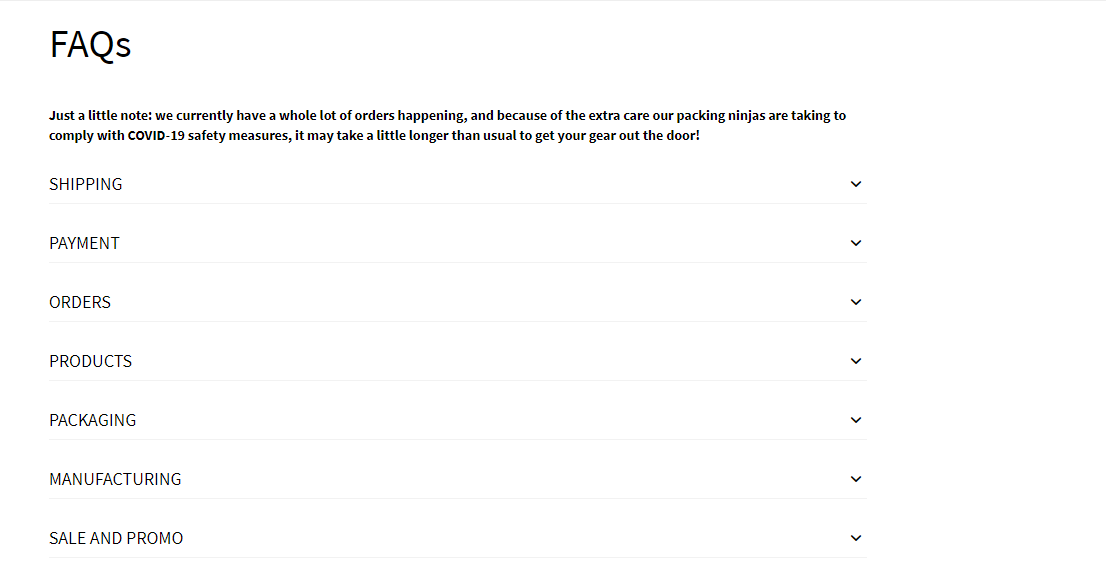
It is another example whose FAQ page is properly organized into topics that cover the whole purchasing journey. Apart from the sales and promo, it also addresses issues related to manufacturing, products, orders, payment, and shipping. There is even no need for a search tool here since navigation is very simple. A customer just needs to expand the topic in which he/she is interested, then proceed straight to the relevant questions.
With such a name of an online shop, it is not surprising that the FAQ page has been set up with an informal tone. Therefore, the customers can enjoy the whole experience-which consequently boosts the conversion rate.
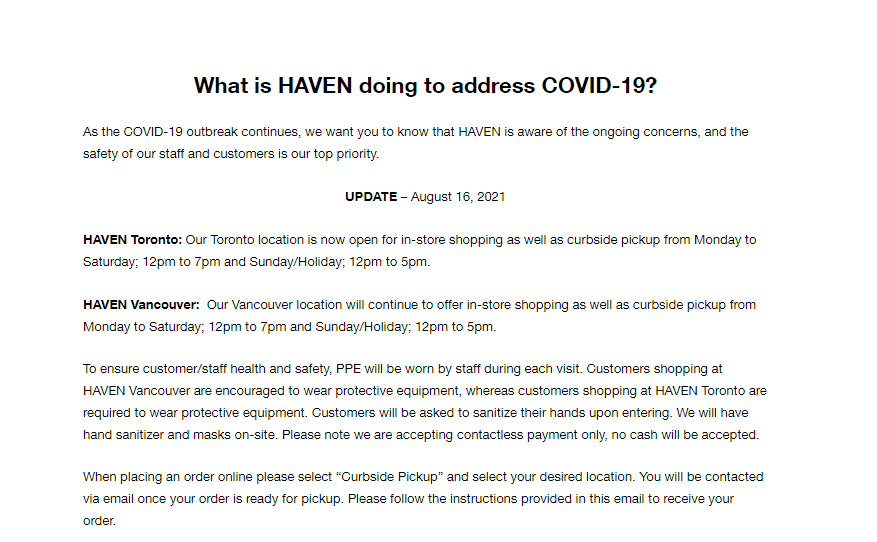
Most of the FAQ pages we have discussed so far have an informal and conversational approach. Haven, on the other hand, uses a different style – the same formal business tone we are used to. It shows the commitment and seriousness of the brand, instead of being playful. Thinking of this, it is good for Haven’s customer base which includes international shoppers.
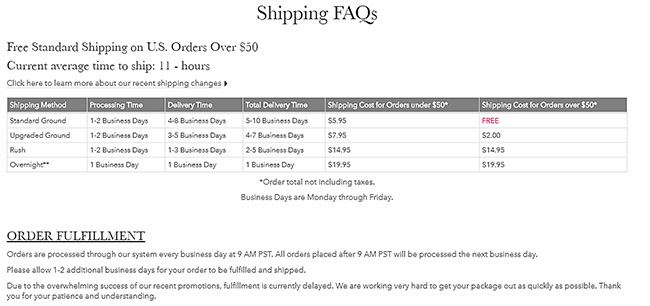
The FAQ page of the 100PercentPure is completely opposite of what we have seen on Haven. While Haven prefers a brief approach, 100PercentPure has used a quite large FAQ system which is constituted of two pages – Shipping FAQs and AfterPay FAQs.
Shipping FAQs cover topics related to order fulfilment and the shipping process. The Q & A’s have been arranged on the basis of their topics and subtopics to help customers navigate easily. On the other hand, the Afterpay FAQ page has information regarding an instalment payment model that the shop’s customers’ commonly use.
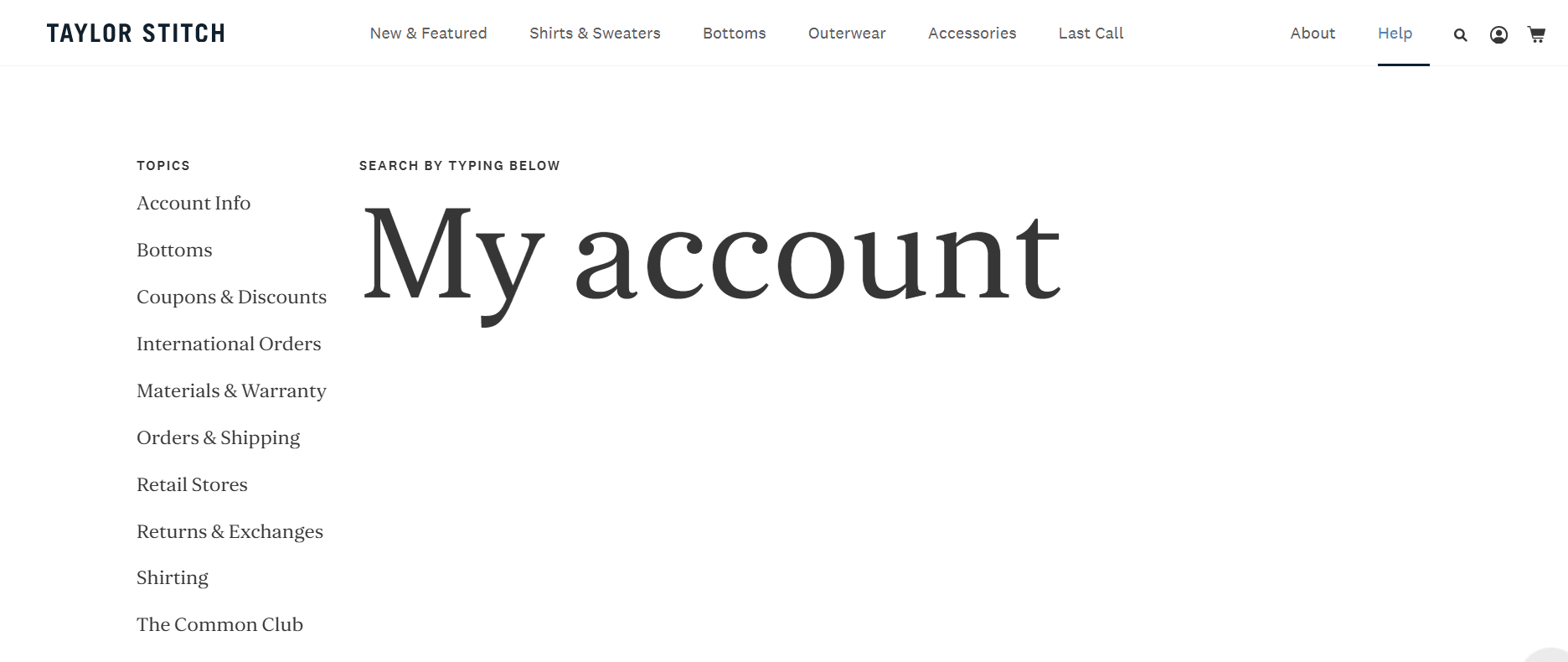
It is a challenging task to create a detailed knowledge base that takes considerable time. And creating a comprehensive FAQ is not a cakewalk. Thus, instead of handling them individually, TaylorStitch has built a holistic FAQ or help blog page. The resultant knowledgebase, therefore, delivers information in the form of questions and answers.
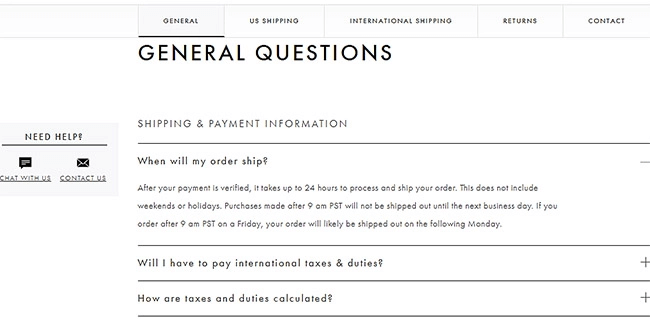
Last but not the least, MvmtWatches follow a minimalistic design in their FAQ page. But remember, only the design is minimalistic but the information is quite extensive. And Mvmt Watches have shared every technical detail related to their watches and the shopping process.
And yes, the whole information is placed in its respective category and subcategory. Customers can use tabs to switch between the principal sections, headers to scroll through various subsections.
Wrapping Up:
In this article, we have gone through all the different aspects of the FAQs Page along with its importance. At Ceymox Technologies, our designers are having expertise in designing such sections to facilitate the shopping journey and improve customer experience. Let us know your requirements.
 Hubspot SEO Certified |  Hubspot SEO II Certified |  Google Ads Search Certified |  Google Analytics Certified |
Sreehari N Kartha is a skilled Digital Marketing Analyst at Ceymox, certified in SEO. His expertise encompasses a wide range of digital marketing strategies, including managing advertising campaigns on platforms like Google Ads, Facebook Ads, Instagram Ads, WhatsApp Ads, and LinkedIn Ads. With a strong foundation in SEO and SMM, Sreehari is adept at optimizing online visibility, driving engagement, and generating qualified leads and conversions. His passion for emerging technologies, such as Crypto, NFTs, and Web3, further complements his skillset, enabling him to navigate the dynamic digital landscape.
View All Articles